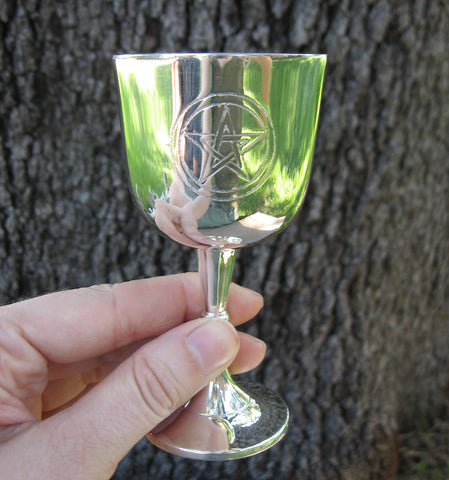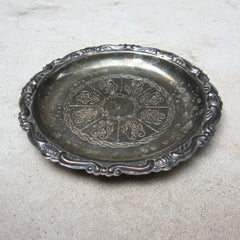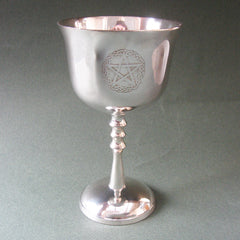
The silver (or silver-plated) chalice is an important ritual tool for many Wiccans and Pagans. The chalice represents the feminine principle and is also used to hold beverage offerings. On a Wiccan altar, the chalice stands for the Goddess, as the athame stands for the God.
Although a ritual chalice can be made of practically anything, silver has a special magickal significance. Silver corresponds to the Moon. In Western magick, it’s linked to receptivity, psychic vision, dreams, change, and the element of Water.
Silver is a beautiful and precious material, but it requires a bit more maintenance than ordinary dishware. Whether you buy a new or vintage chalice, here are some tips to keep your silver looking its shiny best:
What is silver plate?
Before we talk about the care of silver items, it helps to understand how they are made. Most silver chalices and cups are silver-plated. This means a layer of precious silver is applied over a less expensive metal core, most often brass. Solid silver tableware does exist, of course, but it is relatively rare and quite expensive. Silver-plating allows the look and feel of silver at a much lower cost.
Electroplating is the usual method for applying a silver finish. An electrical current is used to apply silver to the conductive base. The result is that the silver surface can be very thin—sometimes only a few microns thick. (For comparison, household aluminum foil is around 15-20 microns.) Time and use (or overzealous polishing) can strip away the silver coating, revealing the base metals underneath. Antique silver cups often have a yellowish cast inside. This is the brass core showing through.
Silver-plated items contain little silver by weight, but that doesn’t mean they are a cheap or inferior product. Until a few decades ago, beautiful silver-plated items were being produced by foundries in the United States, Europe and India—including prestige brands like Tiffany. Now that formal entertaining has gone out of style, the demand for new silver tableware is very low. Sadly, lots of pretty old silver is being sold for scrap. Many historic silver factories are going out of business or switching to decorative wares.
Silver chalices are still being made by companies that cater to churches and Pagan practitioners. But this is a niche market. As a result, finding a vintage silver chalice may get harder and harder as the years go by.
What is tarnish? What is patina?
Like many metals, silver has the property of tarnishing. When the metal is exposed to the oxygen, hydrogen, and sulphur in the air, a thin layer of corrosion forms on the surface. Silver tarnish can range from yellow-gold to black, depending on the amount of silver oxide that has accumulated on the surface. Silver sulfide is responsible for the iridescent rainbow effects found on some old silver.
Air pollution and humidity can cause silver to tarnish faster. But even under carefully controlled conditions, all silver will tarnish eventually. The grand households of yesterday must have had an army of workers to keep all the silver shining!
Not all tarnish is bad, however. Beautiful old silver is said to have a patina—an appealing combination of tarnish and wear. Many metals look quite charming with a bit of corrosion acquired over time. In silver, black tarnish settles into the recesses and curves of the object, making the decorative elements even more dramatic. Some collectors feel the worst thing you can do is polish a patinaed artifact to a mirror finish.
The difference between tarnish and patina is something like the difference between a flower and a weed. Meaning it all depends on whether you find this type of finish desirable.
A vintage chalice covered in silver patina looks very mystical indeed! However, if you’re going to drink from your chalice, you may prefer to remove the tarnish for a cleaner look and feel. In the latter case, it’s always an option to polish the inside of the cup, and leave the outside alone.
Care and keeping of your silver chalice

If all your chalice needs is a simple cleaning, you can wash it by hand. Use a mild detergent (liquid dish or hand soap) and water. Dry your chalice thoroughly before storing it, because any water left on the surface will speed tarnishing. It’s not a good idea to put silver items in the dishwasher, as the harsh detergent, heat, and presence of other metals can damage the finish.
Removing tarnish? The best way to polish a silver chalice is with a polishing paste and a soft, lint-free cloth. Apply the silver polish, and buff to your desired finish. (I use Wright's—or Simichrome for tougher spots—and a piece of clean T-shirt fabric.) A soft old toothbrush will help with any hard-to-reach areas. Give it a thorough hand-washing when you’re done to remove leftover cleaning chemicals.
Avoid cleaners with abrasives and strong acids. Silver “dip” solutions are fast, but they strip away a lot of metal and shorten the life of your silver plate. Also use care when trying home remedies like salt and lemon, baking soda, or toothpaste. Many of them are too grainy and will scratch silver. If you want a DIY solution, try it first on an inconspicuous spot, like the inside or base of your chalice.
Acidic liquids (such as wine and fruit juice) cause silver to wear out faster. Try not to leave them in your chalice for extended periods.
Is it safe to drink from a silver chalice?
Generally, yes. Silver is completely harmless in the miniscule amounts ingested from silver tableware. This is true for both tarnished and untarnished silver. The only people who need to worry about their silver exposure are silver miners, welders, and people taking colloidal silver quack medicine.
What about silver plate? In vintage silver plate, some people worry about spots where the silver plate has worn out, exposing the base metal. Most of the time, it’s not a cause for concern. The underlying metal is usually brass (a copper alloy), pewter (tin alloy), or cupronickel (mix of copper and nickel). Copper, zinc, tin, and nickel alloys are safely used in drinkware—even the modern stuff.
With a very old silver chalice, there is a small chance that the underlying metal could contain lead. Some old formulas of pewter included lead, before the hazards were widely known. If your chalice is a true antique, consider using a home lead test kit. Or consult an expert who can tell you more about how and when the piece was made. If you can’t be sure, it may be safest to retire the chalice from beverage use.
Using a vintage chalice in ritual

For Witches and Pagans, concerns about used rituals items go beyond topics like lead and tarnish. Magickal people feel that objects carry energy from their previous owners and, for lack of a better word, experiences. These leftover vibes have the power to influence magickal workings in ways you may not intend. Since I started buying and selling vintage chalices, one of the most common questions I get is, “Is it okay to use a vintage chalice in ritual?”
I’m a bit biased, of course, because I absolutely love the energy and appearance of vintage Pagan tools. It makes me proud to have something on my altar that didn’t come from one of the major catalogs. I believe in reducing waste and consumerism. And there’s something exciting and subversive about using a cup for a Pagan ritual after it’s sat through many a boring country club banquet.
With the chalice, at least, I don’t find energetic contamination to be an issue. It may be a bigger concern with other vintage tools, such as blades. But the energy of most old cups and goblets is quite lovely! Which makes sense: Even in the mundane world, cups are used for celebration, hospitality, commemoration, indulgence. Most of these things are in perfect harmony with the occult purposes of the chalice. Basically, there’s not much you can do with a cup to corrupt its basic cup-ly nature.
When adopting it for ritual use, treat a vintage, antique, or secondhand chalice much the same as you would treat a new one. Give it a thorough physical and energetic cleansing, and dedicate it to your magickal needs in a way that is meaningful to you.
A sample cleansing: Wash your chalice inside and out under running water. As you clean it, visualize removing the energy you don’t want, while leaving what is charming and unique. (Much like washing off old wine goo without disturbing the underlying patina.) Run it through the smoke from White Sage or a Lunar incense, such as Sandalwood or Jasmine. Finally, place it out in the moonlight overnight—perhaps with a little offering for the Fae. Ta-da! Your vintage chalice is ready for its new role as a magickal object.
Related: Magickal properties of silver



